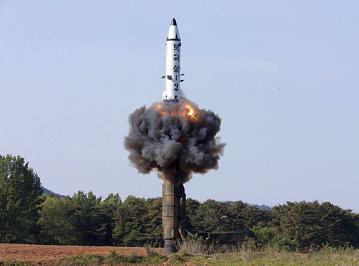by WorldTribune Staff, May 22, 2017
North Korea said its latest test of an intermediate-range ballistic missile passed all technical requirements to enable the missile to be mass-produced and deployed, according to a state media report.
The North said it successfully fired the Pukguksong-2 missile into waters off its east coast on May 21, its second missile test in a week. The missile flew about 500 kilometers (310 miles), reaching an altitude of 560 kilometers, South Korea’s military said.

State news agency KCNA claimed that Kim Jong-Un supervised the test. The report said the test confirmed reliable late-stage guidance of the warhead and the functioning of a solid-fuel engine as Pyongyang advanced its ambitions of being able to hit the United States.
Related: North Korea’s warhead re-entry test puts U.S. ‘forward-based assets’ at risk, May 16, 2017
KCNA said last week’s missile test put Hawaii and Alaska within range.
Western missile technology analysts say North Korea’s claim that its missiles can now reach the U.S. is exaggerated. Some analysts believe it will take until 2030 or later for the North to develop the technology, while others point to the rapid advances in recent years.
KCNA quoted Kim as saying the Pukguksong-2 met all the required technical specifications and should now be mass-produced and deployed to the Korean People’s Army strategic battle unit.
The U.N. Security Council is due to meet on May 23 behind closed doors to discuss the latest test, which defies Security Council resolutions and sanctions, at the request of the United States, Japan and South Korea, according to a Reuters report.
“We cannot absolutely tolerate the missile launch on May 21 and repeated provocative remarks and actions by North Korea,” Japan’s Chief Cabinet Secretary Yoshihide Suga said on May 22.
“It is important to lower North Korea’s foreign currency earnings and prevent nuclear missile related shipment and technological transfer in order to prevent North Korea’s nuclear missile development. We will fully implement our own sanctions against North Korea.”
Analysts say solid fuel engines and mobile launchers make it more difficult to detect signs of launch preparations.
“For military purposes, solid-fueled missiles have the advantage that they have the fuel loaded in them and can be launched quickly after they are moved to a launch site,” David Wright, co-director of the Global Security Program at the U.S.-based Union of Concerned Scientists, said in a blog post.
“Building large solid missiles is difficult,” he said, adding it took decades for major superpowers such as France and China to go from a medium-range missile to an intercontinental ballistic missile.
